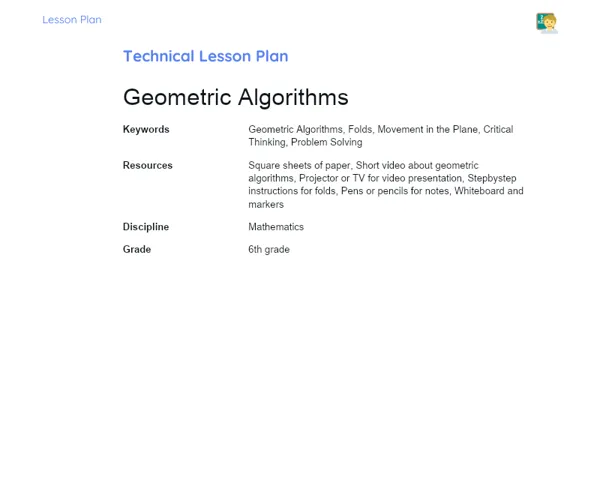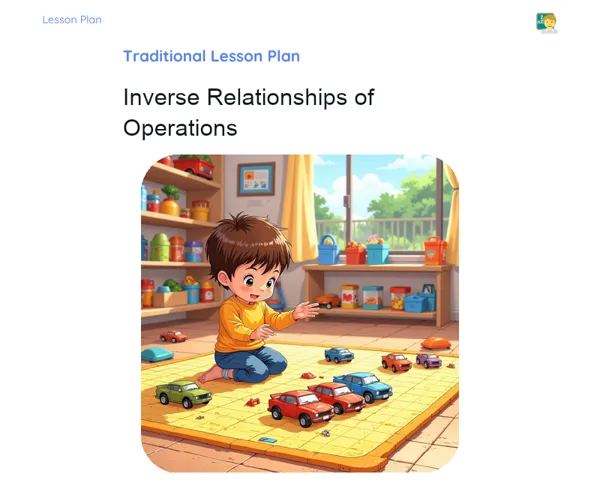Lesson Plan | Active Methodology | Algebraic Expressions
| Keywords | Algebraic expressions, Properties of operations, Problem-solving, Practical learning, Interactive activities, Group work, Logical reasoning, Contextualization, Engagement, Educational games, Practical application, Group discussion, Collaborative review, Resolution strategies |
| Necessary Materials | Algebraic expression cards, Large board for the race, Play money for market simulation, Price list for market activities, Clues for the mystery game, Markers or tokens for the board, Whiteboard and markers, Paper and pens for jotting notes |
Premises: This Active Lesson Plan assumes: a 100-minute class duration, prior student study both with the Book and the beginning of Project development, and that only one activity (among the three suggested) will be chosen to be carried out during the class, as each activity is designed to take up a large part of the available time.
Objective
Duration: (5 - 10 minutes)
The objectives stage is crucial for guiding both students and teachers on the focus areas of the lesson. By setting clear aims for what students should accomplish, this section acts like a roadmap for future activities, ensuring everyone involved understands the learning expectations. The objectives will steer practical classroom activities, allowing students to apply their prior knowledge in an effective and engaging manner.
Objective Utama:
1. Help students hone their skills in solving algebraic expressions by applying arithmetic operation properties to equations with variables, such as in the example 2x + 4x - 3x.
2. Enable students to recognise and work with algebraic expressions in multiple contexts, fostering logical reasoning and practical application of their mathematical knowledge.
Objective Tambahan:
- Encourage students to participate actively through group discussions and collaborative problem-solving.
- Boost students' self-confidence in tackling mathematical challenges involving algebraic expressions.
Introduction
Duration: (15 - 20 minutes)
The aim of this introduction is to spark students' interest in the lesson topic through relatable problem situations that effectively illustrate the concept of algebraic expressions. This connection between theory and real-world application could enhance motivation to learn and appreciate the subject.
Problem-Based Situation
1. Imagine your buddy is saving up to buy a new video game that costs R500. They've already got R200 and plan to save R{x} per month. After 3 months, will they have enough to buy the game? What amount is 'x'?
2. A company manufactures and sells 'x' units of a product for R20 each. If the fixed production cost is R1000 and the variable cost per unit is R5, how many units ('x') should be sold to break even?
Contextualization
Algebraic expressions pop up all around us, from budgeting personal expenses to scrutinising profits in large corporations. Understanding how to manipulate these expressions not only helps students tackle mathematical problems but also hones analytical skills crucial for various aspects of life. Moreover, mastering algebraic expressions enhances logical reasoning, preparing students for more complex challenges in their studies and careers.
Development
Duration: (75 - 80 minutes)
This development stage is key for allowing students to apply concepts learned in a practical and engaging way. The proposed activities aim to reinforce students' understanding of algebraic expressions through interactive and community-focused methods. By collaborating in groups, students also enhance their social and teamwork skills while keeping maths relevant and fun. Opting for just one activity ensures deep exploration of the topic and guarantees all students take part in problem-solving.
Activity Suggestions
It is recommended that only one of the suggested activities be carried out
Activity 1 - The Great Expression Race
> Duration: (60 - 70 minutes)
- Objective: Allow students to practice solving algebraic expressions in a fun and collaborative way, reinforcing their understanding of addition, subtraction, and simplification of algebraic terms.
- Description: In this fun activity, students will be split into groups of up to 5 to participate in a relay race focusing on algebraic expressions. Each group will get a set of cards with incomplete expressions they must complete accurately to move onto the next stage of the race. The expressions will involve addition, subtraction, and simplification of algebraic terms. The game will be set up on a large board in the classroom, where each space represents a stage of the race.
- Instructions:
-
Divide the class into groups of up to 5 students.
-
Explain the rules: each group starts in the same position on the board, and each time they correctly solve an expression card, they move one space forward.
-
Distribute the expression cards to each group.
-
The first group to reach the finish line on the board, having solved all expressions correctly, wins.
-
After the activity, conduct a review of the expressions with the whole class.
Activity 2 - Expressions in the Market
> Duration: (60 - 70 minutes)
- Objective: Apply their knowledge of algebraic expressions in a financial management scenario, enhancing their calculation and strategic reasoning skills.
- Description: Students will take on the role of managing a small fruit stall where they’ll need to apply algebraic expressions to calculate profits, losses, and restocking. Each group will receive a starting amount of 'money' and a list of buying and selling prices. They’ll need to decide how much to buy, calculate potential profits, and adapt their strategies as the game unfolds.
- Instructions:
-
Form groups of up to 5 students and hand out the 'money' and price lists.
-
Explain that they need to calculate profits based on the provided algebraic expressions for various buying and selling scenarios.
-
Allow the groups to simulate purchases and sales, refining their strategies as they go.
-
At the end, discuss which strategies worked best and the expressions used.
Activity 3 - Mathematical Mystery
> Duration: (60 - 70 minutes)
- Objective: Foster skills for solving algebraic expressions within a mystery game framework, enhancing teamwork and logical thinking.
- Description: In this mystery-solving activity, students will employ their skills to solve algebraic expressions to uncover clues hidden around the classroom. Each solved clue leads them to the next one, ultimately revealing 'who done it'. Puzzles will revolve around adding, subtracting, and simplifying algebraic terms.
- Instructions:
-
Hide clues around the classroom that can only be found by solving algebraic expressions.
-
Divide the class into groups of up to 5 students.
-
Provide each group with the first clue to kick off the game.
-
Groups must solve the expressions to progress through the clues until they solve the mystery.
-
Lead a discussion on the strategies employed to find solutions after the activity.
Feedback
Duration: (10 - 15 minutes)
This section of the lesson plan is vital for consolidating what students learned through practical activities. Group discussions offer students the chance to reflect on their thought processes and problem-solving methods, while also learning from their peers. This interaction bolsters understanding of mathematical concepts and encourages better retention of knowledge. Sharing ideas stimulates a collaborative learning environment.
Group Discussion
Kick off the group discussion with a general review of the activities performed. Ask students how they felt solving algebraic expressions through the fun activities and any challenges they faced. Prompt them to share their strategies and insights on the use of algebraic expressions in everyday life. Use this time for each group to report back on their learning and how they applied their algebraic knowledge to tackle the proposed problems during the activities.
Key Questions
1. What were the main challenges faced when solving algebraic expressions during the activities?
2. How did working together with classmates help in finding solutions?
3. What insights about algebraic expressions can you transfer to real-life situations outside of class?
Conclusion
Duration: (5 - 10 minutes)
The conclusion stage serves to reinforce students’ understanding, offering a moment to review and reflect on what they’ve learned. By summarising key concepts, the lesson strengthens memory and comprehension, while discussing practical applications of what they've learned highlights the topic’s relevance. This moment is crucial for linking the theory studied with the hands-on activities carried out, ensuring effective and meaningful learning.
Summary
To wrap up the lesson, it’s important to go over the concepts of algebraic expressions discussed. Throughout the session, students had the chance to explore how to use the properties of arithmetic operations in expressions involving variables, such as 2x + 4x - 3x, and tackled contextual problems involving these expressions.
Theory Connection
Today’s lesson was structured to connect theoretical principles with practical application through diverse and engaging activities. Students translated theory into real-world situations, such as games and simulations, facilitating better understanding and retention of the mathematical concepts covered.
Closing
Understanding algebraic expressions is fundamental for students, as it helps them develop essential analytical skills needed to tackle complex problems across a variety of contexts, both in academia and in everyday life. Mastering algebraic expressions paves the way for grasping more advanced concepts in mathematics and other fields of study.


